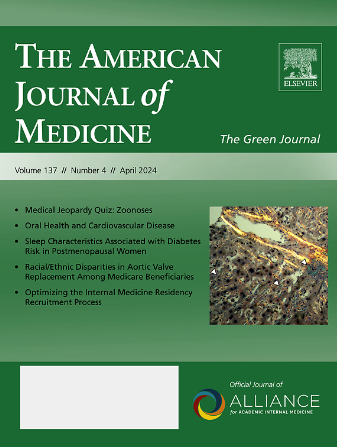Effectiveness of Audit and Feedback and Academic Detailing Interventions to Support Safer Opioid Prescribing in Primary Care
IF 5.3
3区 医学
Q1 MEDICINE, GENERAL & INTERNAL
引用次数: 0
Abstract
Background
Opioids, prescribed to manage pain, are associated with safety risks. Quality improvement strategies such as audit and feedback and academic detailing may improve prescribing in primary care.
Methods
We used a matched-cohort design with claims databases. Participants were family physicians practicing in Ontario, Canada. The interventions were a voluntary audit and feedback report with or without academic detailing sessions. Physicians in the control group received neither intervention. The primary outcome was mean rate of high-risk opioid prescriptions per 100 patients per month. Data were analyzed comparing monthly percentage change in slope over 12 months before and 18 months after the intervention. Additional analyses considered only the subgroup of higher-prescribing physicians.
Results
There were 1469 (25%) physicians in the audit and feedback group, 245 (4%) in the audit and feedback + academic detailing group, and 4211 (71%) matched controls. All groups showed a significant preintervention decline in opioid prescribing. There were no significant between-group differences in opioid prescribing postintervention. Among high-prescribing physicians, there was a significant reduction in the audit and feedback group (% change in slope = –0.37, 95% CI = –0.65 to –0.09, P < .01), but not in the academic detailing group (% change in slope = 0.19, 95% CI = –0.52 to 0.91, P = .59).
Conclusions
This study demonstrated declining secular trends in prescribing and suggests that two large-scale initiatives had limited additional benefits. We found some additional reductions after audit and feedback among the highest-volume opioid prescribers. Future interventions should focus on these physicians for the greatest benefit.
审计与反馈和学术细化干预措施在支持基层医疗机构更安全地开具阿片类药物处方方面的效果。
背景:阿片类药物是用于控制疼痛的处方药,存在安全风险。质量改进策略(如审计和反馈以及学术细节)可改善初级医疗处方:方法:我们利用索赔数据库进行了匹配队列设计。方法:我们利用索赔数据库进行了配对队列设计,参与者为在加拿大安大略省执业的家庭医生。干预措施包括自愿审计和反馈报告,以及或不包括学术详述课程。对照组的医生没有接受任何干预。主要结果是每月每 100 名患者的高风险阿片类药物处方平均率。对数据进行了分析,比较了干预前 12 个月和干预后 18 个月的每月百分比变化。附加分析仅考虑了处方量较高的医生亚组:审计和反馈组有 1469 名医生(25%),审计和反馈+学术细节组有 245 名医生(4%),匹配对照组有 4211 名医生(71%)。所有组的阿片类药物处方量在干预前都有明显下降。干预后阿片类药物处方量在组间无明显差异。在高处方量医生中,审计和反馈组的处方量明显减少(斜率变化百分比 = -0.37,95%CI = -0.65 至 -0.09,p < 0.01),但学术细节组的处方量没有明显减少(斜率变化百分比 = 0.19,95%CI = -0.52 至 0.91,p = .59):本研究显示了处方量下降的长期趋势,并表明两项大规模举措带来的额外益处有限。我们发现,在对阿片类药物处方量最大的医生进行审核和反馈后,处方量有了一定程度的减少。未来的干预措施应侧重于这些医生,以获得最大收益。
本文章由计算机程序翻译,如有差异,请以英文原文为准。
求助全文
约1分钟内获得全文
求助全文
来源期刊

American Journal of Medicine
医学-医学:内科
CiteScore
6.30
自引率
3.40%
发文量
449
审稿时长
9 days
期刊介绍:
The American Journal of Medicine - "The Green Journal" - publishes original clinical research of interest to physicians in internal medicine, both in academia and community-based practice. AJM is the official journal of the Alliance for Academic Internal Medicine, a prestigious group comprising internal medicine department chairs at more than 125 medical schools across the U.S. Each issue carries useful reviews as well as seminal articles of immediate interest to the practicing physician, including peer-reviewed, original scientific studies that have direct clinical significance and position papers on health care issues, medical education, and public policy.
 求助内容:
求助内容: 应助结果提醒方式:
应助结果提醒方式:


